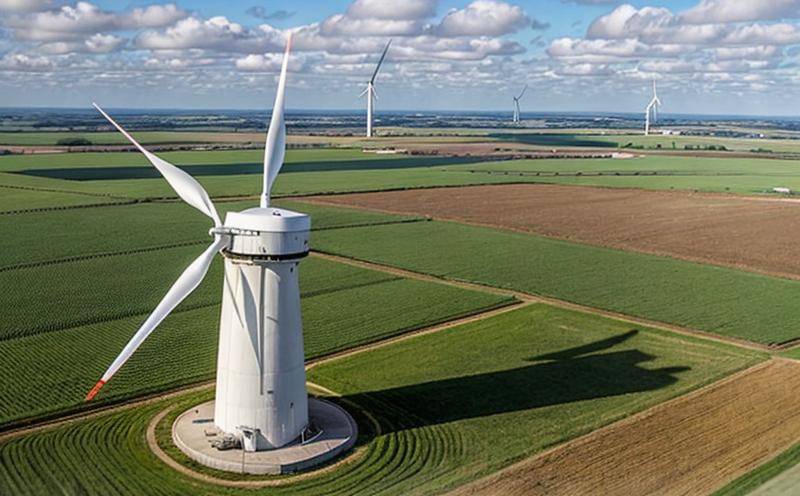IEC 61400-2 Small Wind Turbine Acoustic Noise Testing
The IEC 61400-2 standard is a critical component of the International Electrotechnical Commission's (IEC) suite of standards for wind turbines. Specifically, this document provides guidelines for the determination and measurement of acoustic noise produced by small wind turbines. This testing ensures that wind turbines meet stringent safety and environmental requirements, which are essential in the renewable energy sector.
Small wind turbines, often referred to as micro-turbines or residential-scale wind generators, play a vital role in decentralized power generation. These devices operate at lower noise levels compared to their larger counterparts due to their smaller size and lower tip-speed ratios. However, even small turbines must comply with stringent noise regulations to ensure they do not disturb the surrounding environment.
The testing procedure outlined in IEC 61400-2 involves multiple stages designed to accurately measure and document the acoustic performance of wind turbines. This includes selecting appropriate measurement points around the turbine, ensuring proper setup of the noise measuring equipment, and conducting tests under controlled conditions that mimic real-world operational scenarios.
Once testing is complete, detailed reports are generated, providing data on the sound pressure levels produced by the turbine at various distances from its location. Compliance with IEC 61400-2 ensures that small wind turbines meet international noise limits set forth in this standard, thereby minimizing any potential complaints or issues related to excessive noise pollution.
Compliance with these standards is not only important for regulatory reasons but also for maintaining public trust and ensuring the successful integration of renewable energy systems into communities. By adhering to IEC 61400-2 guidelines, manufacturers can demonstrate their commitment to sustainable practices while reducing risks associated with non-compliance.
The testing process itself involves several key steps: - Establishing a baseline measurement - Conducting the actual noise measurements under specified conditions - Analyzing results against predefined limits - Documenting findings in comprehensive reports
- Baseline Measurement: Initial recordings to establish reference levels.
- Noise Measurements: Comprehensive assessment conducted at different angles and distances from the turbine site.
- Data Analysis: Interpretation of collected data using established criteria.
- Reporting: Compilation of test results into detailed documentation for review by relevant parties.
Quality and Reliability Assurance
Compliance with IEC 61400-2 is not just about meeting legal requirements; it's also a testament to the quality and reliability of your product. By adhering strictly to these standards, you're ensuring that your small wind turbine operates efficiently and safely under various conditions.
Quality assurance in this context means maintaining consistent performance across all units produced by your company. This includes rigorous testing during manufacturing processes as well as ongoing monitoring after installation. Reliable products lead to satisfied customers who are more likely to recommend your brand, fostering long-term relationships within the industry.
Furthermore, reliable data generated through IEC 61400-2 compliance helps identify areas for improvement in future designs and manufacturing processes. This continuous feedback loop allows companies to innovate and stay ahead of competitors by offering superior products that meet evolving market demands.
International Acceptance and Recognition
The global nature of the renewable energy sector means compliance with international standards like IEC 61400-2 is highly valued. Many countries have adopted these guidelines as part of their national regulations, making them a key factor in determining whether products can enter specific markets.
Recognition by international bodies such as the International Electrotechnical Commission (IEC) lends credibility to your testing procedures and results. This recognition is particularly important for companies aiming to expand their operations globally or seeking certification from third-party auditors who specialize in sustainability practices.
Moreover, adherence to these standards can facilitate smoother interactions with regulatory bodies responsible for enforcing environmental protection laws. A proven track record of compliance enhances communication between stakeholders involved in the development and deployment of renewable energy technologies.
Why Choose This Test
Selecting the correct testing method is crucial when it comes to ensuring compliance with IEC 61400-2 standards. Here are some reasons why choosing this test is advantageous:
- Regulatory Compliance: Ensures that your product meets international regulations, which can help avoid costly penalties and legal issues.
- Market Access: Meeting these standards opens doors to export markets where stringent noise control requirements are enforced.
- Consumer Confidence: Demonstrates a commitment to quality and environmental responsibility, enhancing brand reputation.





